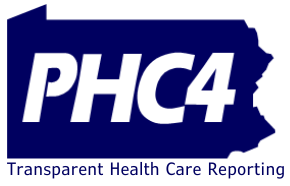Contact: Joe Martin
717-232-6787 or
PENNSYLVANIA RESIDENTS SPENT OVER ONE MILLION DAYS IN THE HOSPITAL FOR TREATMENT OF MENTAL DISORDERS IN 2018: NEW PHC4 RESEARCH BRIEF RELEASED IN CONJUNCTION WITH MENTAL ILLNESS AWARENESS WEEK
Harrisburg, PA – October 9, 2019 – According to a new research brief released today by the Pennsylvania Health Care Cost Containment Council (PHC4), there were 113,704 hospital admissions for Pennsylvania residents for treatment of a mental disorder in 2018âa figure that translates into an average of 312 hospital admissions per day. The total number of hospital days for patients treated for mental disorders reached 1,162,371 days. The average stay was 10.2 days.
Covering residents of all ages, the brief shows patients aged 18-44 accounted for the most admissions at 50.8% (57,738 admissions). Those aged 45-64 accounted for 27.2% (30,892 admissions), and those aged 65 and older made up 7.3% (8,295 admissions). The youngest age group, residents under age 18 accounted for 14.8% (16,779 admissions).
âOur goal in releasing this brief during Mental Illness Awareness Week is to be mindful of how Pennsylvania residents are affected by mental disorders,â said Joe Martin, PHC4âs Executive Director. âProviding this information by county can help communities understand needs at the local level,â added Martin.
At 44.0%, depression was the most frequent reason for a mental disorder admission, followed by schizophrenia at 20.7% and bipolar disorder at 20.2%. Suicidal patients accounted for 4.2%, and trauma-related disorders, including adjustment, post-traumatic stress, and dissociative disorders, accounted for 3.6% of the mental disorder admissions.
The brief also examines population-based rates. Statewide, there were 88.8 hospital admissions for mental disorders per 10,000 Pennsylvania residents in 2018. Rates vary by population demographics:
- The rate was 163.3 per 10,000 for residents living in high poverty areas (where greater than 25% of the population lives in poverty). The rate was 53.0 for residents living in areas of lower poverty (where up to 5% of the population lives in poverty).
- At 159.4 per 10,000, the rate was higher for residents living in areas with lower levels of education (where 10% or less of the population has a bachelorâs degree). The rate was 58.4 for residents living in areas with higher levels of education (where 40% or more of the population has a bachelorâs degree).
- The rates for black (non-Hispanic), white (non-Hispanic) and Hispanic residents were 154.0, 81.7, and 67.9, respectively.
County-level population-based rates are also included in the brief.
The brief is available on PHC4’s website at www.phc4.org. You can also link to it through social media on Facebook and Twitter.
PHC4 is an independent state agency charged with collecting, analyzing and reporting information that can be used to improve the quality and restrain the cost of health care in Pennsylvania.

